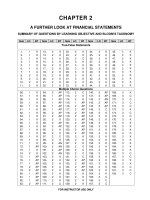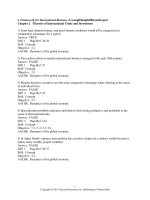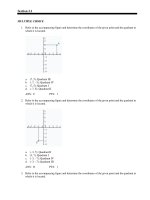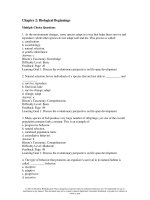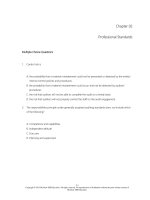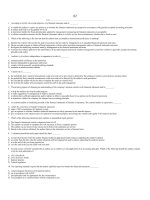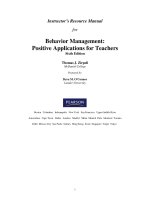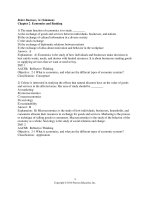International business 6th edition wild test bank
Bạn đang xem bản rút gọn của tài liệu. Xem và tải ngay bản đầy đủ của tài liệu tại đây (214.45 KB, 36 trang )
International Business, 6e (Wild/Wild)
Chapter 2 Cross-Cultural Business
1) Nokia Corporation uses its knowledge of cultures to adapt its mobile handsets to suit local
markets.
Answer: TRUE
Diff: 1 Page Ref: 43
AACSB: Dynamics of the global economy; Multicultural and diversity understanding
Skill: Concept
Objective: Chapter 2-LO1
2) The first step in analyzing a nation's potential for international business activity is to examine
its customs.
Answer: FALSE
Diff: 1 Page Ref: 44
AACSB: Dynamics of the global economy; Multicultural and diversity understanding
Skill: Concept
Objective: Chapter 2-LO1
3) Ethnocentricity improves the ability to manage new business practices abroad.
Answer: FALSE
Diff: 2 Page Ref: 44
AACSB: Dynamics of the global economy; Multicultural and diversity understanding
Skill: Concept
Objective: Chapter 2-LO1
4) Democratic nations that value freedom of speech do not regulate economic sectors such as
broadcasting.
Answer: FALSE
Diff: 2 Page Ref: 45
AACSB: Dynamics of the global economy; Multicultural and diversity understanding
Skill: Concept
Objective: Chapter 2-LO1
5) Subcultures seldom exist in democratic countries with large populations.
Answer: FALSE
Diff: 1 Page Ref: 46
AACSB: Dynamics of the global economy; Multicultural and diversity understanding
Skill: Concept
Objective: Chapter 2-LO1
6) Subcultures share the same language, lifestyle, values, and attitudes as the dominant culture.
Answer: FALSE
Diff: 2 Page Ref: 46
AACSB: Dynamics of the global economy; Multicultural and diversity understanding
Skill: Concept
Objective: Chapter 2-LO1
1
Copyright © 2012 Pearson Education, Inc. Publishing as Prentice Hall
7) Mexican immigrants living in the United States comprise a subculture.
Answer: TRUE
Diff: 1 Page Ref: 46
AACSB: Dynamics of the global economy; Multicultural and diversity understanding
Skill: Concept
Objective: Chapter 2-LO1
8) All Chinese citizens are fluent in the official Mandarin dialect.
Answer: FALSE
Diff: 2 Page Ref: 46
AACSB: Communication abilities; Dynamics of the global economy; Multicultural and
diversity understanding
Skill: Concept
Objective: Chapter 2-LO1
9) A nation's cultural boundaries do not always correspond to its political boundaries.
Answer: TRUE
Diff: 2 Page Ref: 46
AACSB: Dynamics of the global economy; Multicultural and diversity understanding
Skill: Concept
Objective: Chapter 2-LO1
10) Some subcultures exist across national borders.
Answer: TRUE
Diff: 2 Page Ref: 46
AACSB: Dynamics of the global economy; Multicultural and diversity understanding
Skill: Concept
Objective: Chapter 2-LO1
11) The cultural component of aesthetics deals with elements such as imagery, symbolism, and
the arts.
Answer: TRUE
Diff: 1 Page Ref: 47
AACSB: Dynamics of the global economy; Multicultural and diversity understanding
Skill: Concept
Objective: Chapter 2-LO2
12) Black is the universal color that symbolizes death and mourning.
Answer: FALSE
Diff: 2 Page Ref: 47
AACSB: Dynamics of the global economy; Multicultural and diversity understanding
Skill: Concept
Objective: Chapter 2-LO2
2
Copyright © 2012 Pearson Education, Inc. Publishing as Prentice Hall
13) When choosing web site addresses or telephone numbers for businesses that serve Chinese
customers, entrepreneurs should attempt to include the number four (4), which is considered to
be particularly lucky in China.
Answer: FALSE
Diff: 2 Page Ref: 48
AACSB: Dynamics of the global economy; Multicultural and diversity understanding
Skill: Application
Objective: Chapter 2-LO2
14) In today's global business world, the use of a 12-hour clock (as opposed to the 24-hour
clock) is universally appropriate.
Answer: FALSE
Diff: 2 Page Ref: 48
AACSB: Dynamics of the global economy; Multicultural and diversity understanding
Skill: Concept
Objective: Chapter 2-LO2
15) When going global with an Internet presence, it is highly beneficial for a business to localize
its web site.
Answer: TRUE
Diff: 2 Page Ref: 48
AACSB: Dynamics of the global economy; Multicultural and diversity understanding; Use of
information technology
Skill: Concept
Objective: Chapter 2-LO2
16) U.S. employees place value on achieving individual results.
Answer: TRUE
Diff: 2 Page Ref: 48
AACSB: Dynamics of the global economy; Multicultural and diversity understanding
Skill: Concept
Objective: Chapter 2-LO2
17) A culture's values tend to be rigid over time.
Answer: TRUE
Diff: 2 Page Ref: 49
AACSB: Dynamics of the global economy; Multicultural and diversity understanding
Skill: Concept
Objective: Chapter 2-LO2
18) Many folk customs that have spread by cultural diffusion to other regions have developed
into popular customs.
Answer: TRUE
Diff: 1 Page Ref: 52
AACSB: Dynamics of the global economy; Multicultural and diversity understanding
Skill: Concept
Objective: Chapter 2-LO2
3
Copyright © 2012 Pearson Education, Inc. Publishing as Prentice Hall
19) The concept of nuclear family that prevails in much of Europe includes grandparents, uncles,
aunts, and cousins.
Answer: FALSE
Diff: 2 Page Ref: 53
AACSB: Dynamics of the global economy; Multicultural and diversity understanding
Skill: Concept
Objective: Chapter 2-LO2
20) Status refers to the way a culture divides its population according to positions within its
social structure.
Answer: TRUE
Diff: 1 Page Ref: 54
AACSB: Dynamics of the global economy; Multicultural and diversity understanding
Skill: Concept
Objective: Chapter 2-LO2
21) Religion strongly affects the kinds of goods and services acceptable to Muslim consumers.
Answer: TRUE
Diff: 2 Page Ref: 58
AACSB: Dynamics of the global economy; Multicultural and diversity understanding
Skill: Concept
Objective: Chapter 2-LO2
22) Hindus and Buddhists both seek "nirvana," a state of eternal happiness.
Answer: TRUE
Diff: 3 Page Ref: 58
AACSB: Dynamics of the global economy; Multicultural and diversity understanding
Skill: Concept
Objective: Chapter 2-LO2
23) French is the most widely used "lingua franca" in international business.
Answer: FALSE
Diff: 2 Page Ref: 62
AACSB: Communication abilities; Dynamics of the global economy; Multicultural and
diversity understanding
Skill: Concept
Objective: Chapter 2-LO2
24) Literacy tests offer a reliable basis on which to compare one nation's education level to
another's.
Answer: FALSE
Diff: 3 Page Ref: 64
AACSB: Communication abilities; Dynamics of the global economy; Multicultural and
diversity understanding
Skill: Concept
Objective: Chapter 2-LO2
4
Copyright © 2012 Pearson Education, Inc. Publishing as Prentice Hall
25) Nations that invest in worker training are usually rewarded with productivity increases and
rising incomes.
Answer: TRUE
Diff: 1 Page Ref: 64
AACSB: Dynamics of the global economy; Multicultural and diversity understanding
Skill: Concept
Objective: Chapter 2-LO2
26) Hong Kong, South Korea, Singapore, and Taiwan have experienced rapid economic
development despite their poor education systems.
Answer: FALSE
Diff: 2 Page Ref: 64
AACSB: Dynamics of the global economy; Multicultural and diversity understanding
Skill: Concept
Objective: Chapter 2-LO2
27) Material culture often displays uneven development across a nation's industries.
Answer: TRUE
Diff: 2 Page Ref: 65
AACSB: Dynamics of the global economy; Multicultural and diversity understanding; Use of
information technology
Skill: Concept
Objective: Chapter 2-LO4
28) Group-oriented cultures are typically found in Europe and North America.
Answer: FALSE
Diff: 2 Page Ref: 68
AACSB: Dynamics of the global economy; Multicultural and diversity understanding
Skill: Concept
Objective: Chapter 2-LO5
29) In cultures with large power distance, prestige and rewards tend to be equally shared between
superiors and rank-and-file employees.
Answer: FALSE
Diff: 3 Page Ref: 68
AACSB: Dynamics of the global economy; Multicultural and diversity understanding
Skill: Concept
Objective: Chapter 2-LO5
30) Cultures that score low on uncertainty avoidance tend to be more open to change and new
ideas.
Answer: TRUE
Diff: 3 Page Ref: 69
AACSB: Dynamics of the global economy; Multicultural and diversity understanding
Skill: Concept
Objective: Chapter 2-LO5
5
Copyright © 2012 Pearson Education, Inc. Publishing as Prentice Hall
31) Typically, the first step in the process of analyzing a nation's potential as a host for
international business activity is to ________.
A) assess its overall business climate
B) analyze its religious environment
C) investigate its history of corruption
D) evaluate its legal system
Answer: A
Diff: 2 Page Ref: 44
AACSB: Dynamics of the global economy; Multicultural and diversity understanding
Skill: Concept
Objective: Chapter 2-LO1
32) Which of the following terms is defined as the set of values, beliefs, rules, and institutions
held by a specific group of people?
A) Customs
B) Rituals
C) Culture
D) Aesthetics
Answer: C
Diff: 1 Page Ref: 44
AACSB: Dynamics of the global economy; Multicultural and diversity understanding
Skill: Concept
Objective: Chapter 2-LO1
33) The belief that one's own ethnic group or culture is superior to that of others is referred to as
________.
A) cultural inheritance
B) cultural diffusion
C) cultural literacy
D) ethnocentricity
Answer: D
Diff: 1 Page Ref: 44
AACSB: Dynamics of the global economy; Multicultural and diversity understanding
Skill: Concept
Objective: Chapter 2-LO1
6
Copyright © 2012 Pearson Education, Inc. Publishing as Prentice Hall
34) Which of the following is the best example of a case in which ethnocentricity undermines an
international business project?
A) International investors avoid investing in an Indian company because they are unsure of
India's committment to free markets.
B) Production falls at a U.S.-owned factory in Japan because workers react negatively to
American management techniques.
C) China relies on its natural resources and inexpensive factory labor to promote its country's
economic development.
D) Korean managers of a manufacturing company are sent to East European plants to learn the
work habits of local workers.
Answer: B
Diff: 3 Page Ref: 44
AACSB: Dynamics of the global economy; Multicultural and diversity understanding
Skill: Application
Objective: Chapter 2-LO1
35) Detailed knowledge about a culture that enables people to live and work within that culture is
called ________.
A) cultural literacy
B) social mobility
C) cultural diffusion
D) aesthetics
Answer: A
Diff: 1 Page Ref: 44
AACSB: Dynamics of the global economy; Multicultural and diversity understanding
Skill: Concept
Objective: Chapter 2-LO1
36) Which one of the following best supports the argument that ethnocentricity should be
avoided in business relationships with other countries?
A) Managers often need time to learn the traits and work habits of other cultures.
B) Cultural literacy can only be gained through fluency in another country's language.
C) Managers from other cultures understand best how to motivate their own employees.
D) Western management principles have been proven to enhance business productivity.
Answer: C
Diff: 3 Page Ref: 45
AACSB: Dynamics of the global economy; Multicultural and diversity understanding;
Reflective thinking skills
Skill: Critical Thinking
Objective: Chapter 2-LO1
7
Copyright © 2012 Pearson Education, Inc. Publishing as Prentice Hall
37) A critic argues that the French government is too restrictive regarding its limitations on
English language usage in product packaging. Which of the following would most likely reflect
the French government's response to the critic?
A) The limitations are designed to stop the diffusion of French traits across European borders.
B) The limitations will decrease over time as France earns more income through international
trade.
C) The limitations are necessary to preserve unique elements of French national culture.
D) The limitations are focused primarily on British imports and do not affect U.S.-made
products.
Answer: C
Diff: 2 Page Ref: 45-46
AACSB: Dynamics of the global economy; Multicultural and diversity understanding;
Reflective thinking skills
Skill: Critical Thinking
Objective: Chapter 2-LO1
38) Which of the following is best defined as a group of people who share a unique way of life
within a larger dominant culture?
A) Caste system
B) Subculture
C) Collective culture
D) Material culture
Answer: B
Diff: 1 Page Ref: 46
AACSB: Dynamics of the global economy; Multicultural and diversity understanding
Skill: Concept
Objective: Chapter 2-LO1
39) Which of the following terms is used to refer to that which a culture considers to be in "good
taste" in the arts?
A) Customs
B) Social structure
C) Manners
D) Aesthetics
Answer: D
Diff: 1 Page Ref: 47
AACSB: Dynamics of the global economy; Multicultural and diversity understanding
Skill: Concept
Objective: Chapter 2-LO2
8
Copyright © 2012 Pearson Education, Inc. Publishing as Prentice Hall
40) An electronics manufacturer is designing a product to be marketed to consumers in Islamic
countries. Which of the following colors should the company use most prominently in its
packaging to make a favorable impression on buyers?
A) Green
B) White
C) Black
D) Orange
Answer: A
Diff: 2 Page Ref: 47
AACSB: Dynamics of the global economy; Multicultural and diversity understanding
Skill: Application
Objective: Chapter 2-LO2
41) Which color is primarily associated with funerals in Japan?
A) Black
B) White
C) Jade
D) Tan
Answer: B
Diff: 2 Page Ref: 47
AACSB: Dynamics of the global economy; Multicultural and diversity understanding
Skill: Application
Objective: Chapter 2-LO2
42) Which of the following terms is used to refer to the ideas, beliefs, and customs to which
people are emotionally attached?
A) Aesthetics
B) Social structure
C) Manners
D) Values
Answer: D
Diff: 2 Page Ref: 48
AACSB: Dynamics of the global economy; Multicultural and diversity understanding
Skill: Concept
Objective: Chapter 2-LO2
43) The United Kingdom and the United States value ________, whereas Japan and South Korea
value ________.
A) the caste system; the class system
B) aesthetics; ethnocentricity
C) individual freedom; group consensus
D) hard work; leisure
Answer: C
Diff: 3 Page Ref: 48
AACSB: Dynamics of the global economy; Multicultural and diversity understanding
Skill: Concept
Objective: Chapter 2-LO2
9
Copyright © 2012 Pearson Education, Inc. Publishing as Prentice Hall
44) Which of the following terms is used to refer to the positive or negative evaluations, feelings,
and tendencies that individuals harbor toward objects or concepts?
A) Customs
B) Attitudes
C) Manners
D) Values
Answer: B
Diff: 1 Page Ref: 48
AACSB: Dynamics of the global economy; Multicultural and diversity understanding
Skill: Concept
Objective: Chapter 2-LO2
45) Which of the following statements is true regarding attitudes?
A) They are quite rigid over time compared to values.
B) They are learned from role models.
C) They are similar from one country to the next because they form within a cultural context.
D) They are developed only toward the most important aspects of life.
Answer: B
Diff: 3 Page Ref: 49
AACSB: Dynamics of the global economy; Multicultural and diversity understanding
Skill: Concept
Objective: Chapter 2-LO2
46) Which of the following terms is used to refer to any element that represents a culture's way
of life, including gestures, material objects, traditions, and concepts?
A) Intangible product
B) Tangible product
C) Aesthetic
D) Cultural trait
Answer: D
Diff: 2 Page Ref: 49
AACSB: Dynamics of the global economy; Multicultural and diversity understanding
Skill: Concept
Objective: Chapter 2-LO2
47) Which of the following statements regarding cultural change is NOT true?
A) Cultural change occurs as new traits are accepted and absorbed into a culture.
B) Cultural diffusion occurs quickly in almost every culture.
C) Globalization is increasing the pace of cultural diffusion.
D) Technological advances are increasing the pace of cultural diffusion.
Answer: B
Diff: 3 Page Ref: 49-50
AACSB: Dynamics of the global economy; Multicultural and diversity understanding
Skill: Concept
Objective: Chapter 2-LO2
10
Copyright © 2012 Pearson Education, Inc. Publishing as Prentice Hall
48) Which of the following refers to the process whereby cultural traits spread from one culture
to another?
A) Cultural imperialism
B) Social mobility
C) Cultural diffusion
D) Cultural literacy
Answer: C
Diff: 2 Page Ref: 49
AACSB: Dynamics of the global economy; Multicultural and diversity understanding
Skill: Concept
Objective: Chapter 2-LO2
49) ________ refers to the replacement of one culture's traditions, folk heroes, and artifacts with
substitutes from another.
A) Cultural imperialism
B) Acculturation
C) Cultural attrition
D) Cultural immersion
Answer: A
Diff: 1 Page Ref: 50
AACSB: Dynamics of the global economy; Multicultural and diversity understanding
Skill: Concept
Objective: Chapter 2-LO2
50) Companies that wish to avoid the charge of cultural imperialism should do which of the
following?
A) Be sensitive to how their activities and products affect people's traditional ways and habits
B) Quickly launch new management practices to avoid prolonged resistance to change
C) Implement new investment projects and management practices only during volatile times
D) Maintain a standardized approach to strategy with policy decisions made at headquarters
Answer: A
Diff: 2 Page Ref: 50
AACSB: Dynamics of the global economy; Multicultural and diversity understanding
Skill: Application
Objective: Chapter 2-LO2
51) When Russian politicians complain about the Snickerization of their culture, they are
complaining about which of the following?
A) Lingua franca
B) Social mobility
C) Cultural identification
D) Cultural imperialism
Answer: D
Diff: 2 Page Ref: 50
AACSB: Dynamics of the global economy; Multicultural and diversity understanding
Skill: Concept
Objective: Chapter 2-LO2
11
Copyright © 2012 Pearson Education, Inc. Publishing as Prentice Hall
52) When a manager walks employees through every step of an assignment and monitors the
results at each stage, this process is called ________.
A) diffusion management
B) situational management
C) mentoring and training
D) workforce mobility
Answer: B
Diff: 2 Page Ref: 51
AACSB: Dynamics of the global economy; Multicultural and diversity understanding
Skill: Concept
Objective: Chapter 2-LO2
53) Which of the following terms is used to refer to appropriate ways of behaving, speaking, and
dressing in a culture?
A) Attitudes
B) Manners
C) Aesthetics
D) Values
Answer: B
Diff: 1 Page Ref: 51
AACSB: Communication abilities; Dynamics of the global economy; Multicultural and
diversity understanding
Skill: Concept
Objective: Chapter 2-LO3
54) A group of senior managers decides to require members of their new Mexican office to take
a course in business etiquette. Several employees speak out against the idea, arguing that the
course is a waste of time. Which of the following would be the most effective response to the
employees?
A) Business people are likely to be understanding if a mistake is made by someone outside the
culture.
B) Most business meetings are held on company property during work time, not during lunch.
C) It is important for business success to display culturally appropriate behavior in social
settings.
D) Non-native speakers may have difficulty understanding the nuances of negotiations in
Spanish.
Answer: C
Diff: 3 Page Ref: 51
AACSB: Dynamics of the global economy; Multicultural and diversity understanding;
Reflective thinking skills
Skill: Critical Thinking
Objective: Chapter 2-LO3
12
Copyright © 2012 Pearson Education, Inc. Publishing as Prentice Hall
55) Arab culture considers the left hand the "________" hand.
A) eating
B) writing
C) personal hygiene
D) greeting
Answer: C
Diff: 3 Page Ref: 51
AACSB: Dynamics of the global economy; Multicultural and diversity understanding
Skill: Concept
Objective: Chapter 2-LO3
56) Which of the following terms is used to refer to habits or ways of behaving in specific
circumstances that are passed down through generations?
A) Customs
B) Attitudes
C) Values
D) Manners
Answer: A
Diff: 2 Page Ref: 52
AACSB: Dynamics of the global economy; Multicultural and diversity understanding
Skill: Concept
Objective: Chapter 2-LO3
57) Sharing food gifts during the Islamic holy month of Ramadan is an example of a(n)
________.
A) custom
B) value
C) ritual
D) attitude
Answer: A
Diff: 2 Page Ref: 52
AACSB: Dynamics of the global economy; Multicultural and diversity understanding
Skill: Application
Objective: Chapter 2-LO3
58) Which of the following terms is used to refer to behavior that is shared by a heterogeneous
group or by several groups?
A) Manners
B) Lingua franca
C) Popular custom
D) Folk custom
Answer: C
Diff: 2 Page Ref: 52
AACSB: Dynamics of the global economy; Multicultural and diversity understanding
Skill: Concept
Objective: Chapter 2-LO3
13
Copyright © 2012 Pearson Education, Inc. Publishing as Prentice Hall
59) ________ are behaviors, often dating back several generations, that are practiced by a
homogeneous group of people.
A) Manners
B) Attitudes
C) Popular customs
D) Folk customs
Answer: D
Diff: 2 Page Ref: 52
AACSB: Dynamics of the global economy; Multicultural and diversity understanding
Skill: Concept
Objective: Chapter 2-LO3
60) The wearing of turbans by Muslims in Asia is an example of which of the following?
A) Folk custom
B) Popular custom
C) Symbolic act
D) Ritual
Answer: A
Diff: 2 Page Ref: 52
AACSB: Dynamics of the global economy; Multicultural and diversity understanding
Skill: Application
Objective: Chapter 2-LO3
61) The practice whereby managers and other employees often try to find jobs inside their own
companies for relatives is known as ________.
A) insider hiring
B) nuclear family association
C) nepotism
D) social stratification
Answer: C
Diff: 1 Page Ref: 53
AACSB: Dynamics of the global economy; Multicultural and diversity understanding
Skill: Concept
Objective: Chapter 2-LO3
62) Which of the following terms is used to refer to a collection of two or more people who
identify and interact with each another?
A) Class system
B) Social tier
C) Caste system
D) Social group
Answer: D
Diff: 1 Page Ref: 53
AACSB: Dynamics of the global economy; Multicultural and diversity understanding
Skill: Concept
Objective: Chapter 2-LO3
14
Copyright © 2012 Pearson Education, Inc. Publishing as Prentice Hall
63) Which of the following is NOT an important element of social structure?
A) Social group associations
B) Social aesthetics
C) Social status
D) Social mobility
Answer: B
Diff: 2 Page Ref: 53
AACSB: Dynamics of the global economy; Multicultural and diversity understanding
Skill: Concept
Objective: Chapter 2-LO3
64) Which of the following terms is used to refer to the process of ranking people into social
layers or classes?
A) Social status
B) Social stratification
C) Social group
D) Social mobility
Answer: B
Diff: 2 Page Ref: 54
AACSB: Dynamics of the global economy; Multicultural and diversity understanding
Skill: Concept
Objective: Chapter 2-LO3
65) A ________ is a system of social stratification in which people are born into a social ranking,
with no opportunity for social mobility.
A) moksha system
B) class system
C) caste system
D) genealogy system
Answer: C
Diff: 1 Page Ref: 54
AACSB: Dynamics of the global economy; Multicultural and diversity understanding
Skill: Concept
Objective: Chapter 2-LO3
66) A ________ is a system of social stratification in which personal ability and actions
determine an individual's social status and mobility.
A) genealogy system
B) moksha system
C) caste system
D) class system
Answer: D
Diff: 1 Page Ref: 54
AACSB: Dynamics of the global economy; Multicultural and diversity understanding
Skill: Concept
Objective: Chapter 2-LO3
15
Copyright © 2012 Pearson Education, Inc. Publishing as Prentice Hall
67) Which of the following is the most common form of social stratification in the world today?
A) Moksha system
B) Class system
C) Caste system
D) Social group system
Answer: B
Diff: 2 Page Ref: 54
AACSB: Dynamics of the global economy; Multicultural and diversity understanding
Skill: Concept
Objective: Chapter 2-LO3
68) Which of the following is the world's single largest religion?
A) Jewish
B) Christianity
C) Islamic
D) Confucianism
Answer: B
Diff: 2 Page Ref: 55
AACSB: Dynamics of the global economy; Multicultural and diversity understanding
Skill: Concept
Objective: Chapter 2-LO3
69) A publisher based in Kazakhstan specializes in books for Islamic readers. The publisher is
considering opening sales offices in Saudi Arabia and Ethiopia. Which country would be the
better choice?
A) Saudi Arabia, because its population is predominantly Islamic
B) Ethiopia, because its population is predominantly Islamic
C) Saudi Arabia, because its population does not favor one religion
D) Ethiopia, because it contains a mix of Islamic and Christian citizens
Answer: A
Diff: 2 Page Ref: 55
AACSB: Dynamics of the global economy; Multicultural and diversity understanding
Skill: Application
Objective: Chapter 2-LO3
70) Which of the following believes that salvation comes from faith in God and that hard work
gives glory to God?
A) Hindus
B) Muslims
C) Buddhists
D) Protestants
Answer: D
Diff: 3 Page Ref: 55
AACSB: Dynamics of the global economy; Multicultural and diversity understanding
Skill: Concept
Objective: Chapter 2-LO3
16
Copyright © 2012 Pearson Education, Inc. Publishing as Prentice Hall
71) The world's second largest religion is ________.
A) Judaism
B) Hinduism
C) Islam
D) Confucianism
Answer: C
Diff: 3 Page Ref: 55
AACSB: Dynamics of the global economy; Multicultural and diversity understanding
Skill: Concept
Objective: Chapter 2-LO2
72) Nations governed by which religion segregate the sexes at certain activities and locations
such as in school?
A) Confucianism
B) Hinduism
C) Buddhism
D) Islam
Answer: D
Diff: 2 Page Ref: 58
AACSB: Dynamics of the global economy; Multicultural and diversity understanding
Skill: Concept
Objective: Chapter 2-LO3
73) For Hindus, the highest goal of life is ________.
A) moksha
B) halal
C) kosher
D) material wealth
Answer: A
Diff: 2 Page Ref: 58
AACSB: Dynamics of the global economy; Multicultural and diversity understanding
Skill: Concept
Objective: Chapter 2-LO3
74) A company that sells products designed for Buddhist and Confucian temples would be most
likely to find customers in which of the following countries?
A) Philippines and Singapore
B) India and Indonesia
C) Thailand and Mongolia
D) Madagascar and Nepal
Answer: C
Diff: 2 Page Ref: 58-59
AACSB: Dynamics of the global economy; Multicultural and diversity understanding
Skill: Application
Objective: Chapter 2-LO3
17
Copyright © 2012 Pearson Education, Inc. Publishing as Prentice Hall
75) Which of the following statements about China is NOT true?
A) China's population includes more than 50 distinct ethnic groups.
B) The Chinese are outspoken and tend to express what they think.
C) Business people are considered important role models for youth.
D) China is home to most of Confucianism's 225 million followers.
Answer: B
Diff: 3 Page Ref: 46,54,59
AACSB: Dynamics of the global economy; Multicultural and diversity understanding
Skill: Synthesis
Objective: Chapter 2-LO2, LO3
76) When translated, the term Shinto means ________.
A) path of the heart
B) way of the gods
C) escape from reincarnation
D) achieving enlightenment
Answer: B
Diff: 3 Page Ref: 60
AACSB: Dynamics of the global economy; Multicultural and diversity understanding
Skill: Concept
Objective: Chapter 2-LO3
77) A Chinese business establishes an office in Hong Kong. It conducts business locally with
vendors and customers who live in Hong Kong. Which of the following would be most effective
as the company's main business dialect?
A) Taiwanese
B) Guanxi
C) Mandarin
D) Cantonese
Answer: D
Diff: 2 Page Ref: 62
AACSB: Communication abilities; Dynamics of the global economy; Multicultural and
diversity understanding
Skill: Application
Objective: Chapter 2-LO3
78) Body language includes all of the following EXCEPT ________.
A) unarticulated thoughts
B) eye contact
C) physical greetings
D) facial expressions
Answer: A
Diff: 3 Page Ref: 62
AACSB: Communication abilities; Dynamics of the global economy; Multicultural and
diversity understanding
Skill: Concept
Objective: Chapter 2-LO3
18
Copyright © 2012 Pearson Education, Inc. Publishing as Prentice Hall
79) Which of the following terms is used to refer to the departure of highly educated people from
one profession, geographic region, or nation to another?
A) Social mobility
B) Elite flight
C) Power vacuum
D) Brain drain
Answer: D
Diff: 2 Page Ref: 64
AACSB: Dynamics of the global economy; Multicultural and diversity understanding
Skill: Concept
Objective: Chapter 2-LO3
80) Which of the following represent aspects of the physical environment that heavily influence
a people's culture?
A) Topography and climate
B) Topography and communication
C) Climate and customs
D) Lifestyle and customs
Answer: A
Diff: 3 Page Ref: 65
AACSB: Dynamics of the global economy; Multicultural and diversity understanding
Skill: Concept
Objective: Chapter 2-LO4
81) Which of the following would likely experience the LEAST amount of cultural diffusion?
A) Two subcultures located on a coast with navigable waterways
B) Two subcultures separated by an impassable mountain range
C) Neighboring cultures located adjacent to each other on a land mass
D) Neighboring cultures located next to each other in a desert climate
Answer: B
Diff: 3 Page Ref: 49-50, 65
AACSB: Dynamics of the global economy; Multicultural and diversity understanding
Skill: Synthesis
Objective: Chapter 2-LO3, LO4
82) Which of the following terms is used to refer to all the technology used in a culture to
manufacture goods and provide services?
A) Intellectual culture
B) Popular culture
C) Hofstede culture
D) Material culture
Answer: D
Diff: 2 Page Ref: 65
AACSB: Dynamics of the global economy; Multicultural and diversity understanding; Use of
information technology
Skill: Concept
Objective: Chapter 2-LO4
19
Copyright © 2012 Pearson Education, Inc. Publishing as Prentice Hall
83) The Kluckhohn-Strodtbeck framework compares cultures along all of the following
dimensions EXCEPT ________.
A) Do people believe that their environment controls them, that they control their environment,
or that they are part of nature?
B) Do people focus on past events, on the present, or on the future implications of their actions?
C) Do people embrace or avoid uncertainty and ambiguity?
D) Do people believe individuals or groups are responsible for each person's welfare?
Answer: C
Diff: 2 Page Ref: 66-67
AACSB: Dynamics of the global economy; Multicultural and diversity understanding
Skill: Concept
Objective: Chapter 2-LO5
84) According to Hofstede's framework, which of the following describes the degree of
inequality between people in different occupations?
A) Power distance
B) Uncertainty avoidance
C) Individualism
D) Collectivism
Answer: A
Diff: 2 Page Ref: 68
AACSB: Dynamics of the global economy; Multicultural and diversity understanding
Skill: Concept
Objective: Chapter 2-LO5
85) According to Hofstede's framework, which of the following is LEAST likely to be valued in
a group-oriented culture?
A) Entrepreneurial risk taking
B) Shared responsibility
C) Collective goals
D) Maintaining harmony
Answer: A
Diff: 3 Page Ref: 68
AACSB: Dynamics of the global economy; Multicultural and diversity understanding
Skill: Concept
Objective: Chapter 2-LO5
20
Copyright © 2012 Pearson Education, Inc. Publishing as Prentice Hall
86) All of the following are dimensions developed by Hofstede for examining cultures EXCEPT
________.
A) individualism versus collectivism
B) power distance
C) uncertainty avoidance
D) caste system versus class system
Answer: D
Diff: 2 Page Ref: 67-69
AACSB: Dynamics of the global economy; Multicultural and diversity understanding
Skill: Concept
Objective: Chapter 2-LO5
87) Which of the following countries would most likely be the slowest to implement cultural
change, based on Hofstede's framework?
A) South Africa
B) Norway
C) Japan
D) Denmark
Answer: C
Diff: 3 Page Ref: 49-50, 67-69
AACSB: Dynamics of the global economy; Multicultural and diversity understanding
Skill: Synthesis
Objective: Chapter 2-LO3, LO5
Scenario: BetsyPurses.com
Betsy Franklin, a young entrepreneur from Philadelphia, started her hand-crocheted purse
business seven years ago. Betsy's business has since thrived and employs 150 people. Most of
Betsy's business is within the United States with an occasional international order. But Betsy
now wants to make a concerted effort to grow international sales and is designing her Web site to
attract more customers located abroad. Betsy is meeting with Bob Rufus, a Web site designer, for
help with the project.
88) In choosing colors that comprise the background of the Web site, Betsy should ________.
A) go for simplicity by using a black-and-white site throughout Asia
B) pick a pastel color scheme for Japan
C) avoid pastel colors in Europe and choose primary colors instead
D) use the same color scheme globally so as to not confuse customers
Answer: B
Diff: 3 Page Ref: 48
AACSB: Communication abilities; Dynamics of the global economy; Multicultural and
diversity understanding
Skill: Application
Objective: Chapter 2-LO2
21
Copyright © 2012 Pearson Education, Inc. Publishing as Prentice Hall
89) Betsy believes her success rests on her careful listening and responding to customers' needs.
To ensure that her customers abroad can provide feedback easily, Betsy should ________.
A) set a fixed time for customers to call, such as from 3 to 5 p.m., Eastern Standard Time
B) switch to the 12-hour clock commonly used outside the United States
C) learn what prospective customers seek to accomplish on her Web site
D) ignore issues related to time since her customers will be familiar with the U.S. system
Answer: C
Diff: 2 Page Ref: 48
AACSB: Communication abilities; Dynamics of the global economy; Multicultural and
diversity understanding
Skill: Application
Objective: Chapter 2-LO2
Scenario: HR Experts, Inc.
You were just hired at HR Experts, Inc., a diverse and global human resources consulting
company. On your first day at work, you are assigned to a trouble-shooting group comprised of
individuals from different cultures. Your team members are Tom, Ketan, Yoshi, Hung Shin, and
Nazam. During the course of the day working in the group, you try to put people's names and
faces with their cultures and beliefs.
90) You overheard Ketan making a remark, "I do not want to come back in the next life as an
insect. I want to do right and achieve moksha." Based on this comment, which religion does
Ketan most likely practice?
A) Buddhism
B) Hinduism
C) Islam
D) Confucianism
Answer: B
Diff: 2 Page Ref: 55-60
AACSB: Dynamics of the global economy; Multicultural and diversity understanding
Skill: Application
Objective: Chapter 2-LO3
91) Hearing Ketan's comment, Tom responded, "I believe that salvation comes from faith in God
and that hard work gives glory to God. So my friend, work hard and have faith in God." Based
on this comment, which religion does Tom most likely practice?
A) Protestantism
B) Buddhism
C) Islam
D) Confucianism
Answer: A
Diff: 2 Page Ref: 55-60
AACSB: Dynamics of the global economy; Multicultural and diversity understanding
Skill: Application
Objective: Chapter 2-LO3
22
Copyright © 2012 Pearson Education, Inc. Publishing as Prentice Hall
92) To celebrate you joining the group, everyone goes to a local restaurant for dinner after work.
When ordering drinks, Nazam says he cannot drink alcoholic beverages because his religion
forbids it, and that he must eat quickly so he can attend evening prayers. Based on these
statements, which religion is Nazam most likely practicing?
A) Shinto
B) Hinduism
C) Islam
D) Confucianism
Answer: C
Diff: 2 Page Ref: 55-60
AACSB: Dynamics of the global economy; Multicultural and diversity understanding
Skill: Application
Objective: Chapter 2-LO3
Scenario: Ian Richards, International Executive
Ian Richards is vice president of new business development for a British-based Internet
company. He will soon attend an international symposium on global Internet marketing in Brazil
where he will meet people from around the world.
93) When Ian attends a luncheon with several Arab delegates he does not know, he should
________.
A) not use his left hand to pour drinks for his Arab associates
B) maintain personal space of about 36 inches
C) avoid steady eye contact
D) bow about 30 degrees to each delegate
Answer: A
Diff: 2 Page Ref: 51, 63
AACSB: Communication abilities; Dynamics of the global economy; Multicultural and
diversity understanding
Skill: Application
Objective: Chapter 2-LO3
94) After the symposium, Ian meets several company vice-presidents from the Japan office.
When meeting with the Japanese associates, Ian should ________.
A) bow around 15 degrees
B) bow around 30 degrees
C) bow around 45 degrees
D) simply shake hands but do not bow
Answer: A
Diff: 3 Page Ref: 63
AACSB: Communication abilities; Dynamics of the global economy; Multicultural and
diversity understanding
Skill: Application
Objective: Chapter 2-LO4
23
Copyright © 2012 Pearson Education, Inc. Publishing as Prentice Hall
95) In attendance with the Japanese vice-presidents is a regional manager, Hideki Yoshimura,
who recently made some business errors that were costly for the company. If Mr. Yoshimura
bows at 45 degrees, Ian should interpret this to mean that ________.
A) Mr. Yoshimura has insulted him
B) Mr. Yoshimura expects an apology
C) Mr. Yoshimura has apologized
D) Mr. Yoshimura perceives himself as Ian's elder
Answer: C
Diff: 1 Page Ref: 63
AACSB: Communication abilities; Dynamics of the global economy; Multicultural and
diversity understanding
Skill: Application
Objective: Chapter 2-LO3
96) Ian ends most of his meetings with the thumbs up signal indicating that all is good. When
meeting symposium representatives from Italy, he should ________.
A) avoid making the gesture
B) tap his nose instead
C) make the gesture as usual
D) make the gesture and then shake all hands
Answer: A
Diff: 2 Page Ref: 63
AACSB: Communication abilities; Dynamics of the global economy; Multicultural and
diversity understanding
Skill: Application
Objective: Chapter 2-LO3
Scenario: Global Trading, Inc.
Global Trading, Inc. (GTI) is a company that manufactures and markets in over 40 countries and
has 75,000 employees. GTI is concerned about understanding and managing not only its
employees abroad, but also its suppliers and customers. Jamie, a consultant with Diversity
Training International, is supervising a cross-cultural project for GTI and proposes using the
Hofstede framework for analyzing cultures. Executives with GTI are interested in the
framework, but they have many questions.
97) Jamie presents GTI managers with the following list of Hofstede dimensions to test their
understanding of the framework. Which dimension would the managers most likely identify as
the one that does not belong?
A) Achievement versus nurturing
B) Individualism versus collectivism
C) Public versus private orientation
D) Power distance
Answer: C
Diff: 1 Page Ref: 67-69
AACSB: Dynamics of the global economy; Multicultural and diversity understanding
Skill: Concept
Objective: Chapter 2-LO5
24
Copyright © 2012 Pearson Education, Inc. Publishing as Prentice Hall
98) Which of the following dimensions would most likely help executives understand the degree
to which employees accept social inequality in different countries?
A) Uncertainty avoidance
B) Individualism versus collectivism
C) Caste system versus class system
D) Power distance
Answer: D
Diff: 1 Page Ref: 67-68
AACSB: Dynamics of the global economy; Multicultural and diversity understanding
Skill: Concept
Objective: Chapter 2-LO5
99) One manager indicates that her subsidiary experiences high turnover, that there are few
formal rules for regulating individual behavior, and that these qualities seems to be characteristic
of the national culture. Which one of Hofstede's dimensions would most likely measure these
qualities?
A) Quantity versus quality of life
B) Uncertainty avoidance
C) Individualism versus collectivism
D) Power distance
Answer: B
Diff: 2 Page Ref: 69
AACSB: Dynamics of the global economy; Multicultural and diversity understanding
Skill: Concept
Objective: Chapter 2-LO5
100) Which of the following dimensions would most likely help a manager understand whether
the lifestyle in her host country is more oriented toward accumulating wealth or maintaining a
balanced life?
A) Achievement versus nurturing
B) Uncertainty avoidance
C) Individualism versus collectivism
D) Power distance
Answer: A
Diff: 1 Page Ref: 69
AACSB: Dynamics of the global economy; Multicultural and diversity understanding
Skill: Concept
Objective: Chapter 2-LO5
101) ________ is the set of values, beliefs, rules and institutions held by a specific group of
people.
Answer: Culture
Diff: 1 Page Ref: 44
AACSB: Dynamics of the global economy; Multicultural and diversity understanding
Skill: Concept
Objective: Chapter 2-LO1
25
Copyright © 2012 Pearson Education, Inc. Publishing as Prentice Hall
